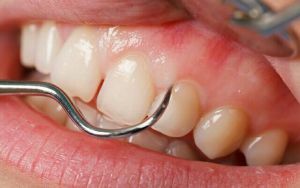 A children's geographical mystery: what river name is in the mouth? Answer: Desna. And if there is a river, then it may well have a cancer.
A children's geographical mystery: what river name is in the mouth? Answer: Desna. And if there is a river, then it may well have a cancer.
And - it starts. The name and sounds: gum cancer - all with a small letter.
Contents
- Maximum aggression - optimum comfort
- Cancer: small war
- Gum oncology: symptomatology and therapy
- Treatment of oncology of gums
- Tooth cancer: one of three sources
- Symptoms in dynamics
- For diagnosis of
- Can we treat tooth cancer?
- How to prevent the development of malignant formations in the mouth
Maximum aggression - optimum comfort
Cancer is a malignant degeneration of tissues, most often the degeneration of the tissues of the areas involved, bordering one another.
Desna is one of such "hot areas".This - the rampart, erected by nature on the way inside the body.
This place:
- intensively loaded( by chewing food, by gnawing or splitting it);
- exposed to the food is very hot and burning( tea, alcohol, salt, pepper), then scalding-ice( ice cream, ice).
Plus the infinite mechanical micro-trauma, obtained during the processing of food. Plus, the constant destroying effect of the microflora of the mouth, "loosening the soil" for their needs.
It is also a place that is affected by various aggressive chemical agents, inhaled or entering the oral cavity( vapors of gasoline, varnishes, paints).And with a disease such as diabetes mellitus with ketoacidosis, the patient literally breathes acetone, which is formed in his body as a result of improper metabolism. 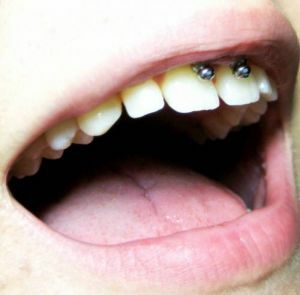
Finally, the constant compulsion of gums to smoke from their master or such an interest as a piercing - the presence in the oral cavity of absolutely unnecessary jewelry for her.
The optimum conditions for malignant tissue degeneration are evident here.
The tooth, for all its seeming monolithic hardness and density, is actually a skin that has evolved in the course of evolution. And, just like the skin, he is prone to degeneration into cancer. For all the factors of aggressive influence on the gums touch the teeth.
They are also the causes of cancer of the teeth and gums.
Cancer: a small war
An indispensable sign of cancer is the destruction of "legally living" tissue and replacing it with another, little or low-grade - tissue with an inferior structure and virtually no function except for one - aggressive growth.
This means that there is a constant displacement of the full tissue from its "place of residence" and filling all the available for the tumor space.
Cancer is always a real little war with the extermination of the indigenous population and rapid deep penetration into neighboring lands.
Gum oncology: symptomatology and therapy
This pathology is the prerogative of men, more often - the elderly.
Gum cancer( most often lower) begins with such uncharacteristic and subtle symptoms as: 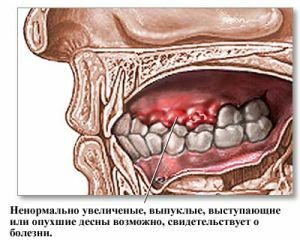
- of the unknown pain character , gradually increasing to the point where opening and closing the mouth becomes a problem;
- causeless minor, but persistent and prolonged bleeding from the gums, arising even with mild pressure on it;
- change in the structure of the of the gingiva( focal seal in the environment of ulcerated or cracked areas);
- progressive swelling of the of the gum, which exerts pressure on the teeth and nearby areas of the oral cavity;
- local change in the color of the surface of the mucosa in the form of redness, blanching, focal pigmentation.
The process of treating gum oncology
In case of suspected gum cancer, the dentist directs the patient to consult an oncologist.
The methods of diagnostics of this type of oncology include:
- examining tissue samples for the presence of cancer cells( biopsy cytology);
- X-ray and computer tomography examination of the gums and jaw for the detection of foci and metastases in adjacent structures and tissues.
Treatment of a tumor consists in the immediate surgical removal of it with subsequent radiation and chemotherapeutic effects on the focus to prevent the spread of metastases to neighboring areas.
The success of therapy is determined both by the size of the tumor and the stage of its development, and by the state of the patient's health and his willingness to actively cooperate with the dental surgeon and oncologist.
With a high level of immunity, the body in the postoperative period is able to cope with the ailment itself, with its low level of
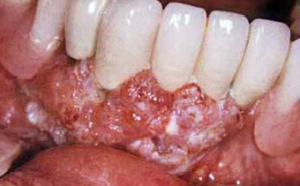
. In the picture, the usual pattern for gum and tooth cancer
is assigned to stimulating drugs and vitamin therapy, if necessary, antibiotics to combat concomitant infection.
The complication of gum cancer is the spread( metastasis) of the tumor through the lymphatic pathways to vital organs, followed by rapid depletion of the body, leading to death.
If the process is neglected to save the patient's life, it may be necessary to remove both the large area of the lymphatic system and part of the tongue, teeth and jaw bones, and taste and smell may be lost.
When the disease penetrates deeper - into the lymph nodes - its treatment becomes extremely difficult, and the prognosis is unfavorable.
Dental cancer: one of the three sources
The formation of a malignant tumor( more often on the lower jaw) occurs from the rudiment of the tooth at the time of cell differentiation into future enamel and dentinal tumors. It is also possible to degenerate the cement fabric that makes up the tooth.
According to the origin of a certain tissue, the tooth cancer can look like: 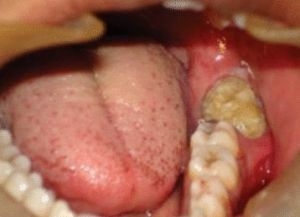
- adamantiloma;
- of odontogenic fibroids;
- cement;
- odontomes.
Symptoms in the dynamics of
Most often, tooth cancer is a finding in the X-ray examination of teeth, developing extremely slowly and not delivering painful sensations, manifested as a loss of the tooth row of the original correct shape, or bulging of the jaw or loosening of the teeth.
Symptoms build up in the development of tooth cancer:
- And only after a considerable time and reaching a fairly large size tumor declares itself fistula formation and pathological fractures due to thinning of the jawbone.
- Finger pressing on the site with the changed structure causes creping of - a sound reminding a crunch of prinimaemogo snow.
- Transmission of nerve endings leads to pain when opening the mouth of and difficulty in swallowing in the advanced stage of the oncological process.
For diagnosis of
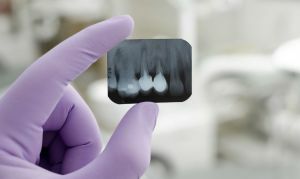 To recognize the early stage of a malignant tumor originating from dental tissues, a careful evaluation of the apparent condition of the jaw and teeth in it, not coinciding with the patient's meager complaints( if any) takes place.
To recognize the early stage of a malignant tumor originating from dental tissues, a careful evaluation of the apparent condition of the jaw and teeth in it, not coinciding with the patient's meager complaints( if any) takes place.
The presence of fistula makes diagnosis easier, but speaks of a far-gone process. To confirm the expected diagnosis serve:
- radiography( panoramic and targeted images of teeth);
- cytological examination of the biopsy specimen.
The final diagnosis and treatment tactics is determined by a medical consultation consisting of a dental surgeon and an oncologist.
The prognosis for this disease is negative: tumor metastasis can provoke cancer by a number of located organs: the lips, the tongue, the larynx, and in its neglected version lead to a fatal outcome.
Can we cure tooth cancer?
In the case of early diagnosis, radical surgical excision of the tumor, followed by radiation exposure and the use of chemotherapy, can restore the patient's health.
How to prevent the development of malignancies in the mouth
For the prevention of cancer, it is necessary:
- carefully and gently to care for the oral cavity;

- is an attentive relationship to the food process, composition and properties of food;
- overcoming harmful habits and eliminating production hazards;
- observance of the doctor's recommendations in the treatment of somatic diseases.
Also necessary is a regular( at least every six months) visit to the dentist who will assess the condition and give the necessary recommendations for maintaining oral health.
